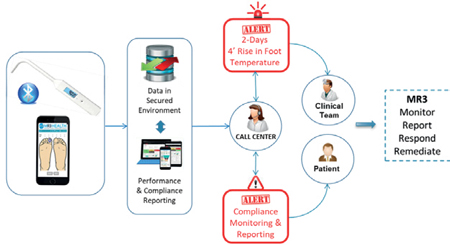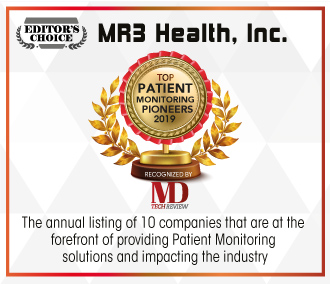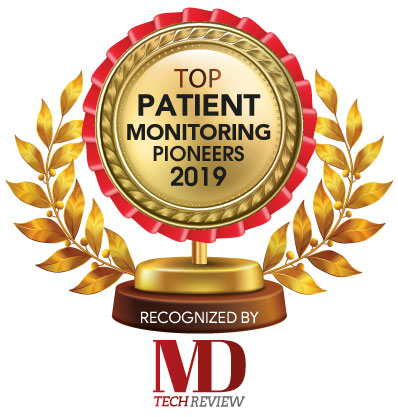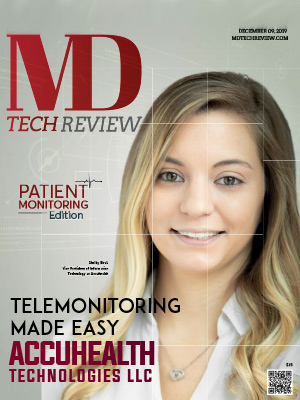 Stan Marett, President
Stan Marett, PresidentAn extensive range of complications associated with diabetes, including circulatory problems, especially in the lower extremities, makes patients more susceptible to inflammation, infection, and neuropathy—degradation and damage to nerve pathways—leading to loss of sensation. These conditions, in addition to the stresses associated with walking, can lead to tissue breakdown and the development of large, subcutaneous ulcers. Patients with “diabetic foot neuropathy” are often unaware of the development of such ulcers, having lost “the gift of pain” to alert them to the danger. With catastrophic delays in identifying ulcers, it is not uncommon for patients to visit their doctor with a deeply developed, gaping wound that requires extensive treatment or, at worst, amputation. For such patients who lack the sensation of pain, routine monitoring of skin temperature can be of great advantage in providing early warnings of inflammation. To this end, Texas-based MR3 Health has developed an Internet of Things (IoT)-connected foot sensor that helps patients monitor the health of their feet daily to prevent foot ulcers.
MR3 Health is a dynamic HealthTech company providing an innovative combination of remote patient monitoring (RPM) service and medical technology to patients and insurers to help prevent the complications associated with chronic diseases like diabetes and hypertension. MR3 monitors patients on a daily basis, identifies those with negative physiologic trends, and communicates alerts to the patient, clinician, and healthcare payer, indicating a high risk of an acute health event, if any.
Preventing Diabetic Foot Ulcers
In the case of patients with “diabetic foot neuropathy,” MR3’s foot sensor takes temperature readings that are uploaded wirelessly into the patient’s personalized cloud database. Over time, the sensor tracks when and where minute temperature changes occur on the patient’s feet and immediately sends alerts if the temperature varies from what is considered normal for that patient. “Our connected foot sensor is based on our FDA cleared medical device—TempTouch™ infrared dermal thermometer. Although the device had proven its efficacy in three published clinical trials, we added Bluetooth technology and a phone app to make it more viable in today’s market. Further, we married these capabilities to a service model that makes preventing diabetic foot ulcers both practical and achievable for financially at-risk providers and their patients,” explains Stan Marett, president of MR3.
MR3’s service model helps patients with diabetic neuropathy succeed by being involved in their preventive care daily, which includes monitoring alerts in temperature spikes, reaching out with reminders if readings are not received for two or more days, and helping facilitate provider-patient action plans with real-time data. Thereby, the company has brought to the table a key missing element in the treatment of patients with diabetic neuropathy: real-time feedback pertaining to the status of patients’ feet when the sensation of pain is absent.
Monitor, Report, Respond, and Remediate
Interestingly, MR3 is an abbreviation for monitor, report, respond, and remediate, which resonates with the company’s motto of saving lives and improving the quality of life while lowering the costs associated with the care of diabetic foot ulcers (DFUs) and lower extremity amputations (LEAs).
-
With 24/7 temperature and patient compliance alerts, we deliver timely reports so that clinicians can update the patient information chart and, in turn, receive appropriate payments from the insurer
MR3 collaborates with clinicians to educate patients and assist them in following a specific self-measurement regiment between office visits for regular monitoring. “Further, with 24/7 temperature and patient compliance alerts, we deliver timely reports so that clinicians can update the patient information chart and, in turn, receive appropriate payments from the insurer. At the same time, our structured monitoring and reporting services enable payers to achieve substantial savings,” states Marett. Besides lowering overall healthcare costs, MR3 effectively responds to temperature and compliance alerts to predict DFUs and prevent LEAs, thus tremendously improving patient care outcomes. In terms of remediation, the company is focused on reducing visits and readmissions through at-home virtual care.
MR3 constantly endeavors to keep patients out of the doctor’s office—detecting patients’ adverse health conditions in a timely manner where effective action can be taken immediately to prevent expensive wound-care procedures. “Typically, individuals diagnosed with diabetes meet with their doctors on a quarterly or half-yearly basis. But what if a patient’s health deteriorates critically between these visits? The only indicator of DFU for patients currently is the visibility of blood, since they can’t feel any pain. And on most occasions, this discovery occurs a little too late, resulting in an acute medical condition and patients being rushed to the emergency room,” mentions Marett. “This is where our temperature monitoring proves beneficial, detecting problems before they occur. Knowing that their feet are being continually monitored gives patients peace of mind about their health, while, from clinicians’ perspective, we eliminate the risk of an emergency showing up at their doorstep.”

In the same vein, MR3 has extended its capabilities beyond diabetic foot ulcers to monitor other types of physiological data such as blood pressure, glucose levels, and more—although the parameters are different, the preventive purpose remains the same. Hence, earlier this year, when the Center for Medicare and Medicaid Services (CMS) introduced three new reimbursement codes grouped in RPM, MR3 decided to capitalize on the opportunity. Today, the company provides assistance to physicians, offering RPM services to their chronically ill patients using multiple physiologic monitoring devices such as blood glucose monitors, pulse oximeters, and smart weight scales, among others. MR3 proactively identifies the need for intervention, thereby providing the opportunity to reduce risk and the potential cost of treatment and hospitalization. This produces a number of positive results for all parties: better outcomes and reduced acute care episodes for patients with chronic conditions including hypertension, diabetes, congestive heart failure, and more; lower healthcare costs for insurers and hospitals; and increased revenue streams for physicians.
Compliance Success and the Future Roadmap
With the predictive benefits of regular monitoring being clearly understood, the real question, for both providers and payers is “will patients do it?” If yes, will they do it routinely enough to reap its maximum benefits? Left on their own, the answer to this question might often be “no,” but the difference here—also the key ingredient for successful prevention—is that MR3 does not leave the patient alone. “Instead, we become partners in their care, reminding them when they lapse in their daily monitoring, responding to alerts, and becoming the early messenger to their doctors or providers,” highlights Marett.
MR3 has even conducted multiple field studies to demonstrate the benefits of partnering with the patients and how a home monitoring service, incorporating both medical device and smartphone technology, can effectively reduce the incidence of foot ulcers in high-risk individuals. Results show that patients who would otherwise be noncompliant can be successful with the company’s collaborative “Team-plus- Technology” approach. MR3’s combination of technology and service—a virtual helper or “coach” to remind and remediate— not only improves compliance but also makes daily temperature monitoring effective, sustainable, and highly practical as a tool for the prevention of DFUs and LEAs.
“We will continue integrating newer medical devices in our RPM services for more extensive data collection at home, thus ensuring higher compliance and better outcomes for all kinds of patients,” says Marett. Beyond receiving data from patients, MR3 also plans to develop the ability to communicate relevant information, responses, surveys, and more directly on patients’ smartphones to enhance further their knowledge and compliance of the chronic diseases they are dealing with. “As we accumulate and analyze increasing volumes of data over the years, we will create smarter algorithms to manage patients more effectively,” concludes Marett.
Company
MR3 Health, Inc.
Headquarters
San Antonio, TX
Management
Stan Marett, President
Description
MR3 Health is a dynamic HealthTech company providing a combination of remote patient monitoring service and medical technology to patients and insurers to help prevent the complications associated with chronic diseases. MR3 monitors patients on a daily basis, identifies those with negative physiologic trends, and communicates alerts to the patient, clinician, and healthcare payer, indicating a high risk of an acute health event, if any. In the case of patients with “diabetic foot neuropathy,” MR3’s foot sensor takes temperature readings, tracks when and where minute temperature changes occur on the patient’s feet, and immediately sends alerts if the temperature varies from what is considered normal for that patient, thus preventing diabetic foot ulcers.





